|
Dive Hatteras
Home Page
Dive Primer -
how to dive Hatteras
Your Diving Skills
Snorkels
Anyone?
Disclaimer
|
|
Why You Need It The open
Atlantic is not the best time to start to figure out just how you are
going to attract the attention of the dive boat that is now 1/2 mile or
more away. You must think about this possibility before
you get separated from the boat in the open ocean and just how you can
survive the ordeal - and you can. Divers spend thousands of dollars on dive equipment,
camera gear and other toys, but often nothing on some simple primary
equipment that just might save your life. There
are many very easy to carry items that truly can save your life by making
it possible for the dive boat, Coast Guard or other searchers to spot you in the
water. After all, finding you is the real problem, picking you up
once you are seen is the easy part. Think for a moment about the
target a diver floating in the water presents. Even with your
BCD fully inflated, generally just your head and maybe your shoulders are
poking out of the water. Your head is about the size of a
coconut and that isn't very much to see from any distance. Now add some wave action and a few whitecaps into the picture and it becomes
almost impossible to spot your head as it bobs up and down in the
ocean. To add to the problem, most dive gear isn't very bright, with the blues and blacks that are so popular
blending right in with the
sea. Unless you are going to be assaulting the beach with the SEAL
team think about adding some bright colors to your gear. What
follows is by no means a complete list of what might work and there may be additional things you can carry
that might improve your chances. The mere possession of any of this
equipment is no guarantee that you will be rescued, but preplanning and
carrying some signaling devices goes a long way to making your rescue even
possible. What You Need Part of the
requirement for diving from our boat is that the divers have some safety signaling devices with them; a whistle and "safety sausage".
This is the absolute bare minimum that a diver should carry on any ocean
dive as you must be able to make an audible signal and improve you chances
of being seen. We keep extras on board and hand them out all the
time to divers that are not prepared. Minimum
Mandatory Items: Whistle and a Safety Sausage
(SMB) Audible
Device - you must have at least the whistle, preferably both the
whistle and the air horn.
|
Whistle
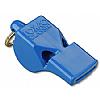
Standard
plastic whistle - It's
only as loud as you can blow, but it always makes noise. Some
can be heard up to 1/2 mile or so in good conditions.
|
 Dive
Alert Air Horn Dive
Alert Air Horn
The
Dive Alert attaches to the BCD hose and uses tank air pressure to make
an ear splitting shriek that is heard for some distance. But if
you are out of air, nothing - so you still need the cheap plastic whistle. The
Dive Alert is the best audible device available and we believe in them
enough to use them on all our loaner gear. The Dive Alert can also inflate your SMB if you hold the valve of the
SMB tight against the horn and push the button. Ask and we
will demonstrate this little known feature. |
Visual Signal
Devices
You have to be seen to be rescued!
There are many devices that can
help you out, some are very low tech - but work, others are high tech and
work great but rely
on batteries.
|
 SMB SMB
One of the best visuals you can have is
the "Safety Sausage" or often called a Surface
Maker Buoy or
SMB (Also called "Tubes" "See Me Buoys"
Etc..).
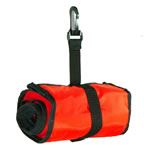 Rolled up and clipped to your BCD it just
hangs there out of the way. Inflated, it stands up and can be
spotted a long ways off. Rolled up and clipped to your BCD it just
hangs there out of the way. Inflated, it stands up and can be
spotted a long ways off.
Don't be cheap. Get one made out of
heavy material with good snaps etc. There are dozens of SMB's on the
market now so pick a good one. The better ones have reflective
tape and some even have attachment points for lights. Dive Alert
makes one model that has LED lighting inside the sausage so the whole
thing lights up! High winds can make them lay over and not stand up
straight,
but the color is the thing.
Try it out before you are in the ocean to make sure you
know how it works. I usually carry two!
Clip it to you before
inflating!
|
The
Rescue Streamer
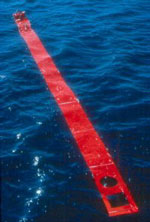
The
Rescue Streamer is a very simple device that is a rolled up piece
of plastic that is high visibility orange. it simply floats on
the water attached to the diver and helps the searchers locate
you. It improves the chance you will be seen from the bridge of the boat or from the
flight deck of the Coast Guard Helicopter.
Attach it to
you before deploying!
|
|
Heliograph
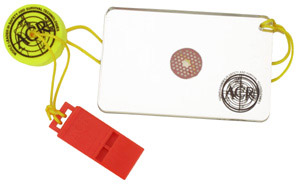
Heliograph is the
technical name, but small plastic or stainless steel mirror is what it really is.
This one is made by ACR
but there are others on the market too. A very low cost item, it can
really get the attention of searchers if used properly, The sun
has to be out for it to work - won't work on overcast days or at
night. You need to take a few minutes and practice with it so
you get the flash going the right place when you need to. Available at most Dive Shops or Marine supply
stores |
Signal
Flares
There
are divers that carry small hand launched flares in their BCD pocket
for emergency signaling on the surface. They work best at night and
most are not guaranteed water proof to diving depths but some do
survive a season of diving.
I have taken my food storage vacuum
bagger and sealed them inside. Carried this way they have lasted
for at least 100 dives in my BC pocket. Don't
waste them until you know a rescuer is nearby and have a back up plan
too...
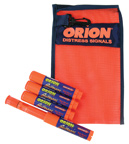
|
|
Chemical
Light Sticks
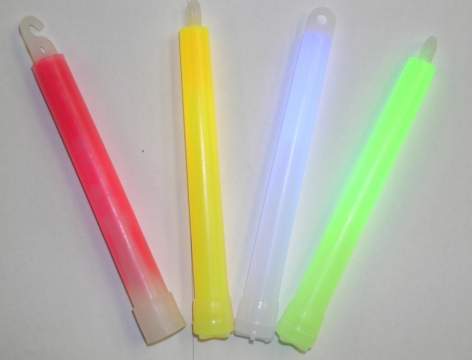
Cheap and easy to use, once it
gets dark even the glow from a light stick will make you stand out
like the Fourth of July as it is really, really, dark at night on the
sea. The down side is they are sometimes already activated when you
rip them out of the package so don't count on them as a primary
device. |
Dive Lights
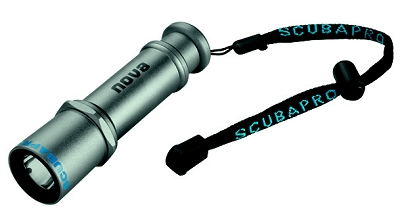
Carry a small flashlight with
you on every ocean dive. The new LED ones are extremely tiny but
have a good strong beam and long battery life. Nothing like a
flashlight beam pointed at the searching boat or aircraft that says,
"Hey Guys! I'm over here!" I carry two lights on
almost every dive...Think about it. |
|
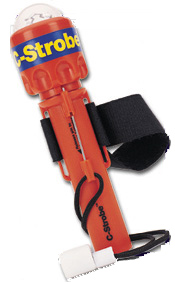 Strobe
Light Strobe
Light
On
a dark and stormy night, there is nothing like the flash of a Xenon
Strobe. Get one that is small, waterproof and relatively
inexpensive. But you must maintain the batteries. Available
at most Dive shops and Marine supply stores for not too much $, but
make sure its depth rated.
|
 Lift
Bags Lift
Bags
A
lift bag can be used to attract the attention you need. One
helped me get located many years ago, in the time way before someone
thought up the SMB. You have to attach it to
you somehow or it will go away and open bottom bags may need attention
at the surface to stay
inflated.
|
The High Tech
Solutions
| The
ultimate solution for the lost diver consists of a radio transmitter
that is carried with them during the dive and activated as needed on the
surface. Now there are two types of radio transmitters, waterproof
VHF/GPS units like the Nautilus Lifeline Radio and EPIRB units.
The EPRIB units broadcast on
406mhz or 121.5mhz, the international
SAR homing frequency, which can be located by the Coast Guard or any
boat/aircraft equipped with a Direction Finding receiver. The 406mhz frequency communicates directly with the satellite
based Search And Rescue system and should work anywhere on the Globe.
Two companies
have produced an 121.5 EPIRB product that is water proof to diving depths, ACR
and Sea Marshall. Recently, I have seen a
few divers onboard carrying small ACR and McMurdo 406mhz PLB EPIRB units in small waterproof
cases. Only a 406mhz unit like these can contact SAR
directly thru the satellites. 121.5 signals are local homing freqs
only and have limited range.
The older PLB units in a
pressure case produce not the most compact design as the one case was about
10x4x5 and the diver
was carrying it in cordura nylon zip pouch on their BC. Seemed
like a good solution, just not ultra compact. The other diver had
his in a waterproof tube that was attached to the utility rings on the
BCD. He added a little float to the McMurdo PLB to ensure it was
buoyant outside of the waterproof tube. Neither solution was elegant,
but both effective. If they activate the unit, someone is going to know where they are
and come looking. The newest ACR PLB is very small about the
size of a pack of cigarettes, so this would be the way to go for a PLB.
We need a manufacture to get
with it and make a totally waterproof PLB unit that needs no housing
good to diving depths.
|
|
Sea Marshall
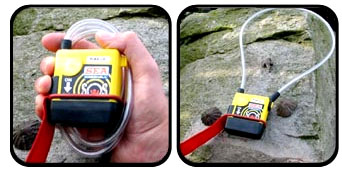
The Sea Marchall beacon is a
fairly small unit that is sealed and depth rated to 100mtrs. To
deploy it the diver places the antenna around their neck and manually
activates the transmitter. It then broadcasts on 121.5 and
requires that someone is looking for you as the US Coast Guard has
recently stopped monitoring 121.5 continuously, but still uses it for
the active search phase of a rescue. 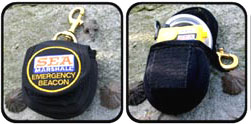 The
Antenna of the Sea Marshall lights up when it transmits, adding that to
the value of the unit. There is a little pouch that can hold the
unit during the dive clipped to your BCD. The
Antenna of the Sea Marshall lights up when it transmits, adding that to
the value of the unit. There is a little pouch that can hold the
unit during the dive clipped to your BCD. 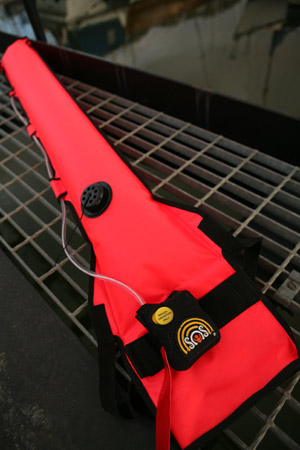 Sea
Marshall also have a SMB that gives you a visual
signal as well as a way to carry the beacon. It also places the antenna much
higher out of the water for increased range. Sea
Marshall also have a SMB that gives you a visual
signal as well as a way to carry the beacon. It also places the antenna much
higher out of the water for increased range.
Cost for a diver unit is apx $350 and a
receiver for the boat is apx $3500. But being found when lost at
sea - priceless. |
ACR Beacon
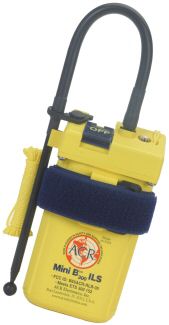 The ACR unit that was
designed for divers was similar to this also discontinued "Mini
B" unit. It is small enough to be carried in most BCD pockets
or strapped on with little effort and is manually activated by the
diver. The diver versions are still in use by several live aboard
groups operating in remote areas. I have not been able to
locate the ACR product and it appears to be discontinued. The ACR unit that was
designed for divers was similar to this also discontinued "Mini
B" unit. It is small enough to be carried in most BCD pockets
or strapped on with little effort and is manually activated by the
diver. The diver versions are still in use by several live aboard
groups operating in remote areas. I have not been able to
locate the ACR product and it appears to be discontinued.
The standard unit is only waterproof to 10mtrs but are plentiful on
ebay but I have not been able to find any of the diver units. Both
ACR units
transmit on 121.5, and operate on the same homing principles as the
Sea Marshall units they just are not as compact nor as cleanly designed, are hard to find and as they age out may not be reliable. |
|
Nautilus
Lifeline Radio
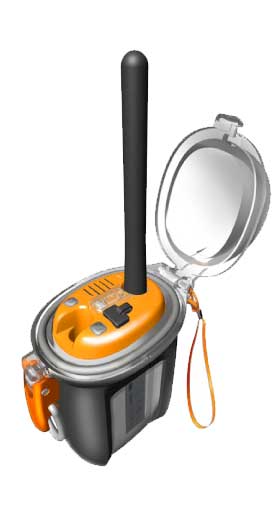 The
other High Tech solution was new in 2011, the original Nautilus
Lifeline Radio and has already been used by many divers to be
rescued. This unit was a very compact VHF radio with a
built in GPS. With the top case closed the radio is water proof to
425 fsw. At the surface the diver can open the top cover and
transmit on VHF channel 16 (Orange button), one other "chat"
channel (Green button), or make
a distress call using the RED button on the radio. Go to our
page about the LIfelines, or Dive
Alert's website
for complete information. The
other High Tech solution was new in 2011, the original Nautilus
Lifeline Radio and has already been used by many divers to be
rescued. This unit was a very compact VHF radio with a
built in GPS. With the top case closed the radio is water proof to
425 fsw. At the surface the diver can open the top cover and
transmit on VHF channel 16 (Orange button), one other "chat"
channel (Green button), or make
a distress call using the RED button on the radio. Go to our
page about the LIfelines, or Dive
Alert's website
for complete information.
Using current DSC (digital
select calling) technology which is in all newer marine VHF radios, any
boat within range will receive the calls from this unit and can talk
back to the diver. On our boat the position of the DSC call from
the Lifeline is
even displayed on the GPS navigation screens. On any other
properly set up dive boats this should also occur.
After looking at these units we
bought them for all the crew on our boat. We are a dealer for this
radio unit and all the other Dive Alert products. The original
VHF radio version of the lifeline is no longer available.
Lifeline chose to redesign the unit to become a
smaller and simpler to use package. The new version of the
lifeline does not have the two way VHF radio functions and does not
require charging. It still has a very accurate GPS and makes the
emergency call using the DCS system but the diver cannot talk to the
rescuers. The package and price got smaller and the Lifeline no
longer needs a desktop interface to field program. Less features,
but still the best thing out there.
If you are serious about your
diving safety, you will own one of these units.
|
The Most Critical Thing
The ultimate survival tool that you
will have with you is not something you buy in the store, but what you
develop as you build your dive experience - the ability to not
panic. If you find yourself adrift in the sea, separated from the
dive boat, the one thing you must do is control your fear and panic.
The same technique that works underwater works on the surface too - Stop,
Breath, Think!
You must not panic!
The equipment you are wearing will
keep you alive a long time even in cooler water temperatures.
You must maintain a positive attitude and take action to make yourself
more visible and stable in the water. Use the equipment
you have to your advantage by fully inflating the BCD to ride as high as
possible. Drop your weights if need be and this action alone may
make a big difference in your ultimate survival. Maintain your
airway by using the snorkel and keep the mask on your face. If you
take off your mask, in a very
short time the saltwater in your eyes will be very irritating and effect
your vision, so keep that mask on!
Think about the gear you have and
deploy what will make you a better target for the searchers to see.
Again, the bottom line is you must be seen to be rescued!
Please
visit this page for procedures on the diving.
This is open ocean wreck diving
- take an advanced class or a shipwreck/ocean diving class if your skills
arenít quite there yet. |

 Dive
Alert Air Horn
Dive
Alert Air Horn
 SMB
SMB
 Rolled up and clipped to your BCD it just
hangs there out of the way. Inflated, it stands up and can be
spotted a long ways off.
Rolled up and clipped to your BCD it just
hangs there out of the way. Inflated, it stands up and can be
spotted a long ways off. 




 Strobe
Light
Strobe
Light Lift
Bags
Lift
Bags
 The
Antenna of the Sea Marshall lights up when it transmits, adding that to
the value of the unit. There is a little pouch that can hold the
unit during the dive clipped to your BCD.
The
Antenna of the Sea Marshall lights up when it transmits, adding that to
the value of the unit. There is a little pouch that can hold the
unit during the dive clipped to your BCD. 
 The ACR unit that was
designed for divers was similar to this also discontinued "Mini
B" unit. It is small enough to be carried in most BCD pockets
or strapped on with little effort and is manually activated by the
diver. The diver versions are still in use by several live aboard
groups operating in remote areas. I have not been able to
locate the ACR product and it appears to be discontinued.
The ACR unit that was
designed for divers was similar to this also discontinued "Mini
B" unit. It is small enough to be carried in most BCD pockets
or strapped on with little effort and is manually activated by the
diver. The diver versions are still in use by several live aboard
groups operating in remote areas. I have not been able to
locate the ACR product and it appears to be discontinued.
 The
other High Tech solution was new in 2011, the original
The
other High Tech solution was new in 2011, the original